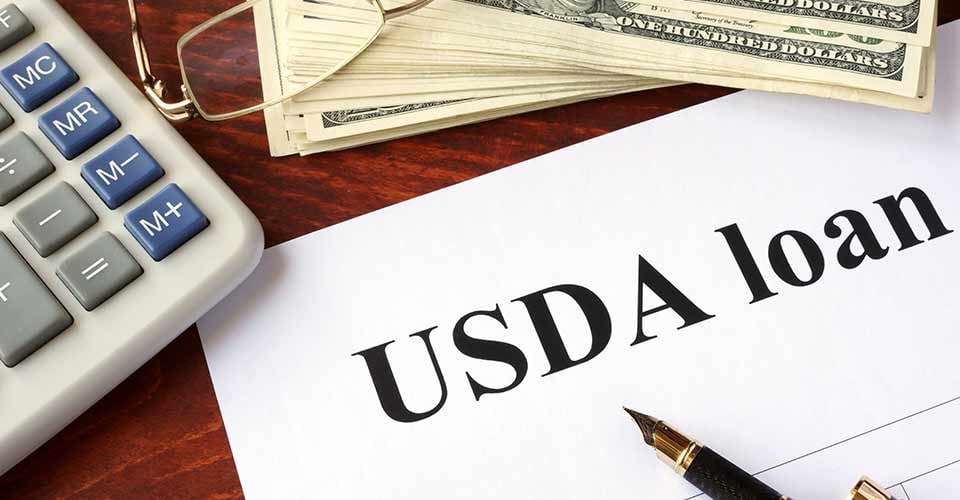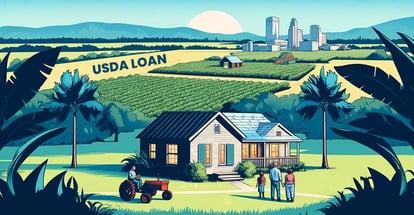Florida USDA Loan FAQ and Changes in 2025
The Florida USDA Loan program has undergone several changes in 2025 that potential borrowers and homeowners should be aware of. This program, designed to aid rural homebuyers in securing affordable housing, remains an essential tool for many individuals.
To ensure you're up-to-date with the latest requirements, modifications, and opportunities, we've compiled this comprehensive FAQ.
By familiarizing yourself with these changes, you can make well-informed decisions when seeking a USDA loan in Florida.
USDA Loan Program Changes in 2024
In 2024, the USDA Loan Program introduced several significant changes that impact eligibility, loan amounts, and other key aspects.
This section delves into these alterations, providing a clear overview for potential borrowers and current loan holders.
USDA Loan Limit Increases in 2024
USDA loan limits are expected to increase in 2024. The USDA announces loan limits annually, and they are typically based on the Federal Housing Finance Agency (FHFA) conforming loan limits for the year.
For 2023, the FHFA conforming loan limit for a single-family home in most areas is $715,000.
However, the USDA loan limit for a single-family home in most areas is $726,200. This is because the USDA uses a different formula to calculate its loan limits, which takes into account the cost of living in rural areas.
The USDA has not yet announced its loan limits for 2024, but it is expected that they will increase in line with the FHFA conforming loan limits. This means that the USDA loan limit for a single-family home in most areas could be as high as $754,500 in 2024.
Of course, the actual loan limits will vary depending on the county in which the property is located.
Additional USDA Loan Program Changes
In addition to the expected increase in loan limits, there are a few other changes coming to the USDA loan program in 2024.
One change is that the USDA is eliminating the recapture requirement for the Section 502 Home Loan Guarantee Program. This means that borrowers who sell their homes within 10 years of taking out a USDA loan will no longer be required to repay the subsidy on their interest rate.
This change is expected to make USDA loans more affordable for low-income borrowers.
Another change is that the USDA is increasing the income limits for the Section 502 Home Loan Guarantee Program. This means that more borrowers will be eligible for USDA loans. The new income limits will be announced in the coming months.
The USDA is also making some changes to its underwriting guidelines. For example, the USDA will now consider borrowers with student loan debt when approving them for USDA loans. This change is intended to make it easier for young professionals to purchase homes in rural areas.
Overall, the changes coming to the USDA loan program in 2024 are positive for borrowers. The elimination of the recapture requirement and the increase in income limits will make USDA loans more affordable and accessible to more borrowers.

25 USDA Loan Frequently Asked Questions in 2024
The USDA Loan Program's modifications in 2024 have prompted numerous questions among potential borrowers and existing homeowners.
This section aims to address the most common queries, offering a clear understanding of the program's current state.
What is a USDA single-family guaranteed home loan?
A USDA single-family guaranteed home loan is a mortgage option offered to eligible rural homebuyers. It is provided through USDA-approved lenders and receives a guarantee from the U.S. Department of Agriculture (USDA).
What does the USDA loan guarantee mean?
The USDA loan guarantee signifies that the USDA ensures a part of each loan should a borrower default. This insurance encourages lenders to grant favorable terms and rates to borrowers due to the added security.
Can both first-time and repeat homebuyers apply for a USDA loan?
Yes, the USDA loan is accessible to both first-time and repeat homebuyers.
Is there a maximum loan amount for USDA loans?
USDA loans do not come with a specified maximum amount. Instead, an individual's loan limit is determined by their debts, income, and repayment capacity.
How much will I pay in closing costs for a USDA mortgage?
Closing costs fluctuate based on the lender and location. For USDA loans, borrowers can utilize gift funds to cover these costs. A gift letter and proof of the fund transfer should be included with your loan application.
What refinance options does the USDA offer?
The USDA provides three refinancing solutions for its borrowers - USDA streamline, streamline-assist, and non-streamlined refinance. However, cash-back refinancing is not available through the USDA.
Do USDA home loans necessitate a down payment?
No, eligible borrowers can procure a home via the USDA loan program without making a down payment.
Are PMI payments required for USDA home loans?
USDA loans entail a one-time upfront USDA guarantee fee, equivalent to 1% of the loan sum.
Additionally, an annual fee, currently at 0.35% of the loan amount, is incorporated into monthly payments. Borrowers can finance this 1% fee into the total loan amount.
What term options do USDA loans provide?
USDA loans can be availed in 30-year or 15-year fixed-rate terms.
How do USDA loan rates compare to others?
Due to the USDA guarantee, its loan rates frequently undercut those of equivalent 30-year fixed-rate conventional mortgages.
How can I determine if my home qualifies for a USDA loan?
Your property must be situated in a USDA-designated rural zone. More details on USDA property qualifications can be found on their website.
What criteria must be met for USDA loan eligibility?
Borrowers should exhibit a credible ability to repay the loan. USDA lenders will examine your income and credit record to affirm this capacity.
What is the minimum credit score for a USDA loan?
The USDA doesn't stipulate a minimum credit score, but to access the USDA's GUS, borrowers should possess a score of 640 or above.
What does the USDA mandate regarding employment for loan eligibility?
Applicants should have consistent employment, typically for at least two years. Self-employed individuals must supply two years of federal tax returns, while retirees need stable income proof.
Can I secure a USDA loan post-bankruptcy?
Yes, borrowers can qualify three years post a chapter 7 bankruptcy discharge or one year after chapter 13 bankruptcy filing.
Is it possible to buy a foreclosed property using a USDA loan?
Yes, USDA loans can finance any property that aligns with USDA property eligibility, which includes foreclosed homes.
Can USDA loans finance investment properties?
No, USDA loans are strictly for primary residences and cannot be used for investment properties.
Can one possess multiple USDA loans concurrently?
No, as the USDA mandates that a buyer's primary residence be the financed property, holding two USDA loans simultaneously is prohibited.
Are modular homes covered by USDA home loans?
Yes, USDA home loans can be utilized to finance modular homes, as long as they meet USDA property eligibility standards.
Can I apply for a USDA loan if I currently own a home?
Yes, you can apply for a USDA loan even if you already own a home. However, the USDA loan program requires that the home financed be your primary residence.
If you're thinking of purchasing a new primary residence in a USDA-eligible area and meet other qualifying criteria, you may be eligible.
How long is the typical processing time for a USDA loan?
The processing time for a USDA loan can vary depending on the lender and the volume of applications they're handling.
Generally, from application to closing, a USDA loan can take between 30 to 60 days. However, it's essential to maintain close communication with your lender for updates and any required documentation.
Are there any restrictions on the type or size of the property I can purchase with a USDA loan?
USDA loans are generally for single-family residences. While there aren't specific size restrictions, the property must be modest in design, size, and cost.
Luxury properties, or those with features not deemed essential to housing, may not qualify. It's crucial to check with your lender or the USDA's specific guidelines to determine property eligibility.
How does the USDA define a 'rural' area for loan eligibility?
The USDA's definition of a 'rural' area is broad.
It doesn't only include countryside locations but can also cover towns, municipalities, and even some suburban areas with populations of less than 35,000.
It's always best to use the USDA's online eligibility map to check if a particular area qualifies.
Is there an income cap to qualify for a USDA loan?
Yes, there are income limits for USDA loans, which vary by region and household size. These limits are set to ensure that the loans are accessible to those who need them most.
It's essential to check the current income limits for your specific area and household size when considering a USDA loan.
Are repairs or renovations allowed with USDA loans?
Yes, the USDA has a program known as the Single Family Housing Repair Loans & Grants. This program allows eligible rural homeowners to repair, renovate, or upgrade their homes.
It aims to ensure that homes meet safety and sanitary standards. Depending on the extent of the repairs and the applicant's eligibility, both loans and grants might be available.
Step-by-Step Guide to USDA Loans
Understand USDA Loan Types
There are primarily two types of USDA loans - Single Family Housing Guaranteed Loan Program (most common) and Single Family Housing Direct Home Loans. Familiarize yourself with each to determine which suits your needs best.
Check Eligibility Criteria
Before applying, ensure you meet the eligibility requirements, which encompass:
- Income limits based on your location and household size.
- Creditworthiness and a minimum credit score (often 640 for automated underwriting).
- U.S. citizenship or permanent residency.
Property Eligibility
Verify that the home you intend to purchase is within a USDA-defined rural area. You can do this using the USDA's online eligibility map.
Select a USDA-Approved Lender
Unlike some other federal loans, you apply for the USDA loan through a private lender. Ensure your chosen lender is USDA-approved.
Gather Necessary Documentation
Compile all required documents, including:
- Proof of current income.
- Recent tax returns.
- Employment verification.
- Debt and credit reports.
- Details about the property you wish to purchase.
Complete the Application
Fill out your lender's USDA loan application. Your lender can provide guidance on any questions you might have.
Go Through Underwriting
Once your application is submitted, it will undergo an underwriting process. The underwriter will review all your documentation to ensure you meet the lending criteria.
Home Appraisal
An approved USDA appraiser will evaluate the property to ensure it meets all USDA standards and determine its market value.
Secure USDA Approval
After the lender's underwriting, your loan will be sent to the USDA for the final sign-off. This step is unique to USDA loans.
Lock in Your Interest Rate
Once approved, you can lock in your interest rate. This guarantees the rate for a set period, ensuring your rate doesn't increase before closing.
Closing
With all approvals secured and the interest rate locked in, you'll attend the closing. Here, you'll sign all necessary paperwork and finalize your USDA loan. Ensure you understand all terms and conditions before signing.
Set Up Payments
Your lender will provide details on how to make monthly repayments. Ensure you make timely payments to avoid penalties or additional interest.
Enjoy Homeownership
With your USDA loan secured, you can now enjoy the benefits and responsibilities of being a homeowner.
Keep open communication with your lender throughout the process. They can provide valuable insights, guide you through each step, and alert you to any additional requirements or potential issues. Regular check-ins can make the process smoother and more understandable.
Bottom Line
The Florida USDA Loan program's modifications in 2024 present significant shifts in eligibility, loan limits, and other key facets that potential borrowers and homeowners need to be aware of.
While the program continues its mission of assisting rural homebuyers in obtaining affordable housing, these changes necessitate a comprehensive understanding to ensure potential borrowers navigate the landscape adeptly.
From loan limit increases, potentially reaching as high as $754,500 for a single-family home in certain areas, to the abolition of the recapture requirement and consideration of student loan debt in underwriting, the changes are extensive and largely beneficial for borrowers.
It's paramount for both prospective homeowners and current USDA loan holders to stay informed about these changes. Doing so not only ensures they can maximize the benefits available but also helps streamline the process and avoid potential pitfalls.
The frequently asked questions section, along with the step-by-step guide, serve as valuable resources for those looking to familiarize themselves with the 2024 adjustments.
For those considering a USDA loan in Florida, staying updated will be instrumental in making well-informed, advantageous decisions.
With over 50 years of mortgage industry experience, we are here to help you achieve the American dream of owning a home. We strive to provide the best education before, during, and after you buy a home. Our advice is based on experience with Phil Ganz and Team closing over One billion dollars and helping countless families.

About Author - Phil Ganz
Phil Ganz has over 20+ years of experience in the residential financing space. With over a billion dollars of funded loans, Phil helps homebuyers configure the perfect mortgage plan. Whether it's your first home, a complex multiple-property purchase, or anything in between, Phil has the experience to help you achieve your goals.


 By
By  Edited by
Edited by 




